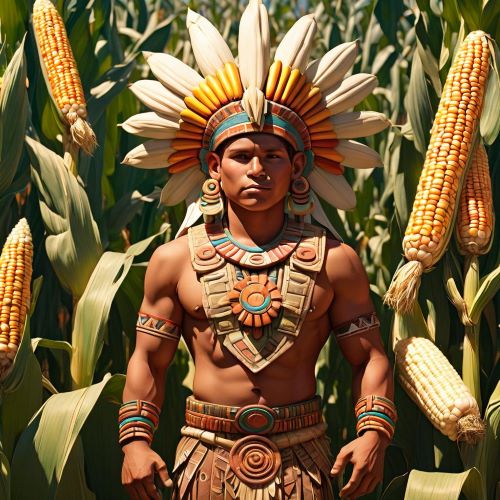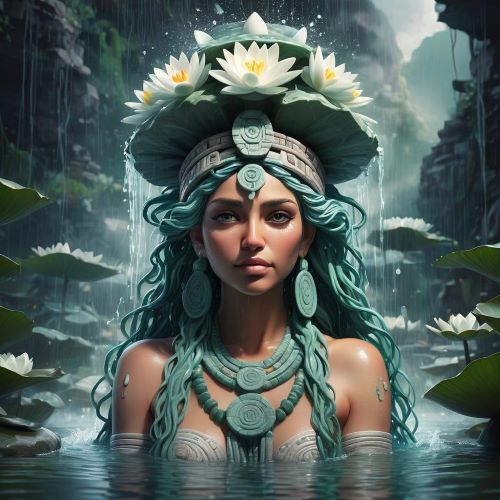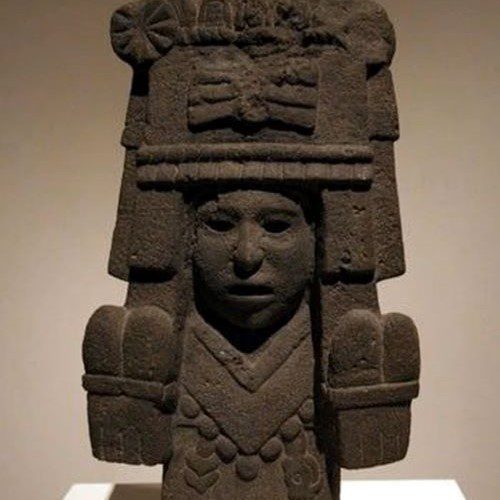Chicomecoatl : Goddess of Agriculture
Listen
At a glance
| Description | |
|---|---|
| Origin | Aztec Mythology |
| Classification | Gods |
| Family Members | Centeotl (Husband) |
| Region | Mexico |
| Associated With | Maize, Agriculture |
Chicomecoatl
Introduction
Chicomecoatl, referred to as “Seven Serpent” in Nahuatl, holds a prominent place in Aztec mythology as the revered goddess of sustenance, particularly associated with corn (maize). This ancient and significant deity in the Valley of Mexico embodies both agricultural prosperity and the feminine essence of maize. As the deity of agriculture, Chicomecoatl, meaning “Seven Serpent,” intertwines her story with the vital ears of corn that nourished the Aztec people. Revered by the ancient Aztecs, Chicomecoatl played a pivotal role in their agricultural rituals and ceremonies, symbolizing the abundant blessings bestowed upon the earth.
Physical Traits
Chicomecoatl’s visual representation often features her with a distinctive red-painted body and face. Notably, she is recognized for her unique rectangular headdress or pleated fan made of red paper. Sculptures of Chicomecoatl frequently depict her holding a double ear of corn in each hand, accompanied by a sunflower shield. Aztec art vividly captures the goddess, showcasing her vibrant and captivating presence.
In these artistic depictions, Chicomecoatl’s red-painted skin symbolizes the lifeblood of the earth, with maize stalks adorning her limbs as a constant reminder of her agricultural domain. However, it is her headdress that truly distinguishes her. Towering above her head like a miniature temple, the “amacalli” or “paper house,” crafted from brightly colored bark paper, serves as a symbol of abundance and fertility. This elaborate crown, adorned with rosettes and intricate designs, resonates with the rustling fields of corn that sustained the Aztec people.
In some representations, Chicomecoatl wears a headdress featuring maize husks and flowers, symbolizing the cyclical nature of growth and harvest. Adding to her distinctive attire, she is commonly portrayed wearing a skirt made of interwoven maize cobs, underlining her close association with corn – a fundamental crop for the Aztecs. These detailed elements in Chicomecoatl’s imagery not only contribute to her aesthetic allure but also convey the rich symbolism and cultural significance embedded in Aztec art.
Family
Chicomecoatl is frequently depicted as the partner of the corn god, Centéotl. Additionally, she is occasionally known as Xilonen, previously wedded to Tezcatlipoca. Her primary association, however, lies with Centéotl, the male maize god. This union symbolizes the harmonious interplay of masculine and feminine energies, as well as the vital balance between the sun and the earth, crucial elements for ensuring prosperous harvests. Together, Chicomecoatl and Centéotl oversee the intricate life cycle of corn, from its delicate sprout to the coveted golden ear. Expanding the complexity of her divine connections, Chicomecoatl is at times identified with Xochitl, the youthful goddess of flowers and beauty, as well as Xochiquetzal, the revered goddess of love and fertility.
Other names
In addition to being recognized as Chicomecoatl and Xilonen, she is also referred to as the “Young Maize-Ear Doll.” While Chicomecoatl remains her most well-known name, the goddess is adorned with various titles, each unveiling a distinct aspect of her identity. Xilonen, meaning “tender ear of corn,” highlights her close association with this essential grain. Chalchiuhtlicue, translated as “precious jade skirt,” signifies her deep connection to water, another life-giving element. Furthermore, Tonacihuatl, meaning “our mother of abundance,” emphasizes her pivotal role as the provider of sustenance for the Aztec people.
Powers and Abilities
In her role as the goddess of sustenance and corn, Chicomecoatl draws her powers from the essence of agriculture and the well-being of human livelihood. The inclusion of the number seven in her name is linked with notions of luck and generative power. Exhibiting a dual nature, she symbolizes both the gathering of maize and the prosperity of agriculture, as well as the potential for harm during periods of poor harvest.
Chicomecoatl presided over the intricate cycles of planting, harvest, and growth, ensuring the flourishing prosperity of the Aztec people. Her abilities included the capacity to summon rain, providing essential nourishment to crops and fending off the threat of drought. Through her blessings, she guaranteed abundant harvests for the communities she watched over. However, her power was not exclusively benevolent. Much like the unpredictable nature of harvests, Chicomecoatl held the potential to bring hardship.
In times of adversity, Chicomecoatl was associated with elements such as hailstorms and floods, natural disasters that posed a threat to the very food security she otherwise provided. This dual aspect of her influence mirrored the precarious balance inherent in agricultural life, where the goddess could be both a source of sustenance and, at times, an unpredictable force capable of challenges and setbacks.
Modern Day Influence
Chicomecoatl’s impact transcends the boundaries of mythology, leaving an indelible mark on cultural and religious practices. She holds particular significance during the Huey Tozoztli festival, a celebration that marks the harvest season. Within this festival, priestesses play a crucial role by designating seed corn for the upcoming planting season. In their efforts to secure a bountiful harvest, priests engage in rituals to appease Chicomecoatl.
Her presence extends to various forms of artistic expression, gracing pottery and murals as a vibrant symbol of the profound connection between humanity and the land. In the contemporary context, Chicomecoatl gains renewed relevance in a world grappling with the challenges of climate change and food insecurity. Her narrative strikes a chord with those who seek a spiritual connection to the Earth and a deeper understanding of the delicate balance between human consumption and ecological sustainability. Chicomecoatl’s story continues to resonate as a source of inspiration for those navigating the complexities of our modern relationship with the environment.
Frequently Asked Questions
What is lorem Ipsum?
I am text block. Click edit button to change this text. Lorem ipsum dolor sit amet, consectetur adipiscing elit. Ut elit tellus, luctus nec ullamcorper mattis, pulvinar dapibus leo.
What is lorem Ipsum?
I am text block. Click edit button to change this text. Lorem ipsum dolor sit amet, consectetur adipiscing elit. Ut elit tellus, luctus nec ullamcorper mattis, pulvinar dapibus leo.
What is lorem Ipsum?
I am text block. Click edit button to change this text. Lorem ipsum dolor sit amet, consectetur adipiscing elit. Ut elit tellus, luctus nec ullamcorper mattis, pulvinar dapibus leo.
What is lorem Ipsum?
I am text block. Click edit button to change this text. Lorem ipsum dolor sit amet, consectetur adipiscing elit. Ut elit tellus, luctus nec ullamcorper mattis, pulvinar dapibus leo.
What is lorem Ipsum?
I am text block. Click edit button to change this text. Lorem ipsum dolor sit amet, consectetur adipiscing elit. Ut elit tellus, luctus nec ullamcorper mattis, pulvinar dapibus leo.







